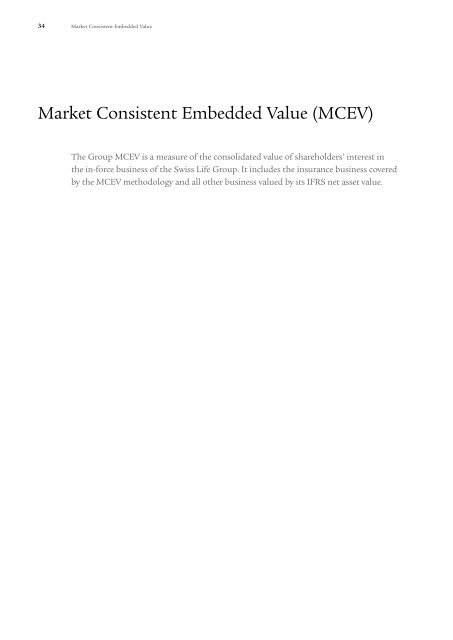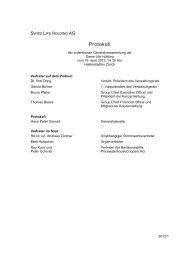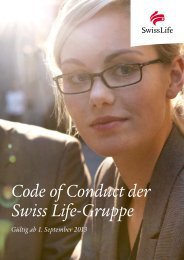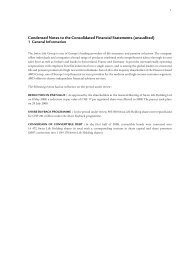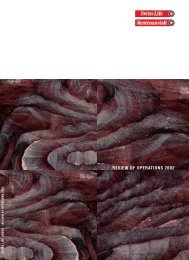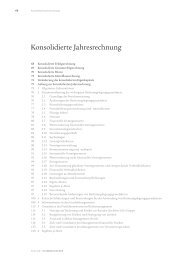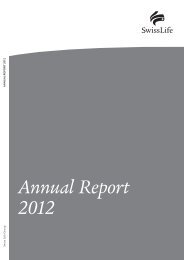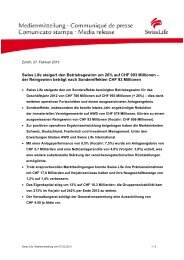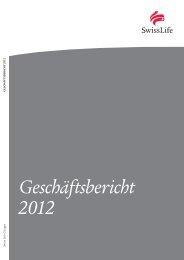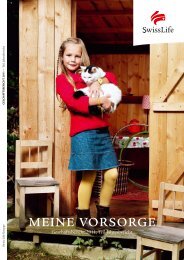Market Consistent Embedded Value (MCEV) - Swiss Life - Online ...
Market Consistent Embedded Value (MCEV) - Swiss Life - Online ...
Market Consistent Embedded Value (MCEV) - Swiss Life - Online ...
- No tags were found...
Create successful ePaper yourself
Turn your PDF publications into a flip-book with our unique Google optimized e-Paper software.
34 <strong>Market</strong> <strong>Consistent</strong> <strong>Embedded</strong> <strong>Value</strong><strong>Market</strong> <strong>Consistent</strong> <strong>Embedded</strong> <strong>Value</strong> (<strong>MCEV</strong>)The Group <strong>MCEV</strong> is a measure of the consolidated value of shareholders’ interest inthe in-force business of the <strong>Swiss</strong> <strong>Life</strong> Group. It includes the insurance business coveredby the <strong>MCEV</strong> methodology and all other business valued by its IFRS net asset value.
<strong>Market</strong> <strong>Consistent</strong> <strong>Embedded</strong> <strong>Value</strong>35Contents36 1 Introduction36 1.1 Basis of Preparation36 1.2 Covered Business and Non-Covered Business36 1.3 Definitions38 2 Summary of <strong>MCEV</strong> Results38 2.1 Group <strong>MCEV</strong>38 2.2 <strong>MCEV</strong> of Covered Business39 2.3 <strong>Value</strong> of New Business41 2.4 Group <strong>MCEV</strong> – Analysis of Earnings42 2.5 Covered Business – Analysis of Earnings44 2.6 Sensitivities44 2.7 Reconciliation of IFRS Net Asset <strong>Value</strong> to Group <strong>MCEV</strong>46 3 Information by <strong>Market</strong> Unit46 3.1 <strong>Market</strong> Units46 3.2 Results by <strong>Market</strong> Unit51 4 Methodology51 4.1 <strong>MCEV</strong> Components for Covered Business53 4.2 New Business53 4.3 Asset and Liability Data54 4.4 Economic Scenario Generator54 4.5 Dynamic Management Actions and Policyholder Behaviour54 4.6 Look-Through Principle54 4.7 Consolidation55 4.8 Employee Pension Schemes and Share-Based Payment Programmes56 5 Assumptions56 5.1 Economic Assumptions58 5.2 Taxation and Legislation59 5.3 Operating Assumptions60 6 External Auditors’ Statement61 7 Glossary and List of Abbreviations<strong>Swiss</strong> <strong>Life</strong> — Financial Statements 2010
36 <strong>Market</strong> <strong>Consistent</strong> <strong>Embedded</strong> <strong>Value</strong>1 Introduction1.1 BASIS OF PREPARATION<strong>Market</strong> consistent embedded value (<strong>MCEV</strong>) is a measureof the consolidated value of shareholders’ interests in thein-force covered business of the <strong>Swiss</strong> <strong>Life</strong> Group. Coveredbusiness includes life, health and pension business of thecompany. The Group <strong>MCEV</strong> is a measure of the consolidatedvalue of shareholders’ interest in the covered andnon-covered business in force of the company. Business inforce includes business written as at 31 December 2010;future new business is not included. The notion of marketconsistent embedded value (<strong>MCEV</strong>) will alternativelyrefer within the course of this report to the <strong>MCEV</strong> of<strong>Swiss</strong> <strong>Life</strong>’s covered business, of one of its market units, orto <strong>Swiss</strong> <strong>Life</strong>’s Group <strong>MCEV</strong>.1.2 COVERED BUSINESS AND NON-COVEREDBUSINESSCovered business includes all of <strong>Swiss</strong> <strong>Life</strong>’s life, healthand pension business as well as assumed external reinsurance,with the exception of <strong>Swiss</strong> <strong>Life</strong> Insurance SolutionsAG and <strong>Swiss</strong> <strong>Life</strong> Products (Luxembourg) S.A.,which are not yet material for <strong>MCEV</strong> purposes. <strong>MCEV</strong>(and Group <strong>MCEV</strong>) are net of ceded external reinsurance.Included are namely operations in Switzerland, France,Germany, Luxembourg, Liechtenstein and Singapore. Allother businesses such as investment management andAWD are generally included in the non-covered businessat their IFRS net asset values, with the exception ofFrance, where they are included in the covered business.<strong>Swiss</strong> <strong>Life</strong>’s market consistent embedded value reportingfollows the European Insurance CFO Forum <strong>Market</strong><strong>Consistent</strong> <strong>Embedded</strong> <strong>Value</strong> Principles ©1 . The cost ofcredit risk relating to bonds is calculated and disclosed inaddition to the Principles’ mandatory requirements.Further details on the <strong>MCEV</strong> methodology are given insection 4.PricewaterhouseCoopers have audited this market consistentembedded value report. Their opinion is part of thisreport and can be found in section 6.1.3 DEFINITIONS<strong>Swiss</strong> <strong>Life</strong>’s Group <strong>MCEV</strong> consists of the <strong>MCEV</strong> for coveredbusiness and the IFRS net asset value for non-coveredbusiness.According to <strong>MCEV</strong> Principle 3, the <strong>MCEV</strong> represents thepresent value of shareholders’ interests in the earningsdistributable from assets allocated to the covered businessafter sufficient allowance for the aggregate risks inthe covered business. It is calculated on a post-tax basistaking into account current legislation and known futurechanges.Components of Group <strong>MCEV</strong>Covered businessCEVTVOGCNHRFCVIF<strong>MCEV</strong>FSRCNAVGroup <strong>MCEV</strong>Non-covered businessIFRSNAVIFRS Equity1 Copyright © Stichting CFO Forum Foundation 2008
<strong>Market</strong> <strong>Consistent</strong> <strong>Embedded</strong> <strong>Value</strong>37The <strong>MCEV</strong> for covered business is broken down into thenet asset value (NAV), i.e., the value of assets not backingliabilities, and the value of in-force business (VIF), i.e., thevalue of future profits emerging from operations andassets backing liabilities.The net asset value is split between:– the required capital (RC): the amount of capitalprovided by shareholders deemed necessary to run thebusiness under the chosen definition (see section 4.1)– the free surplus (FS): additional capital allocated to thecovered business above the required capitalThe value of in-force covered business is defined as thesum of:– the certainty equivalent value of future profits (CEV)– the time value of financial options and guarantees(TVOG), including the cost of credit risks– the cost of residual non-hedgeable risks (CNHR)– the frictional costs of required capital (FC)The IFRS net asset value (IFRS NAV) is defined as theunadjusted IFRS net asset value allocated to the non-coveredbusiness.For more details about the <strong>MCEV</strong> components, see section4 on methodology. Please note that the notion of certaintyequivalent value is equivalent to the notion of presentvalue of future profits in the CFO Forum Principles.<strong>Swiss</strong> <strong>Life</strong> — Financial Statements 2010
38<strong>Market</strong> <strong>Consistent</strong> <strong>Embedded</strong> <strong>Value</strong>2 Summary of <strong>MCEV</strong> ResultsDuring 2010, the capital markets were characterised bystrong movements of the relevant interest rates and adecline of the euro and the US dollar against the <strong>Swiss</strong>franc. While interest rates recovered from their historiclows in the third quarter, they are still below their levels asper end of year 2009 while their volatilities increased. Inthe context of the ongoing margin management and topreserve current and future margins, the company has,among various reassessments performed during 2010,adjusted its approach to policyholder participation.All results and components are shown in CHF million.Rounding differences may occur.2.1 GROUP <strong>MCEV</strong>The following table shows <strong>MCEV</strong> key results as at31.12.2010 compared to the results as at 31.12.2009:In CHF million<strong>Value</strong> ofNet asset value in-force business Total Total2010 2009Covered business 1 928 3 032 4 959 4 132Non-covered business 2 636 n/a 1 2 636 2 745GROUP <strong>MCEV</strong> 4 563 3 032 7 595 6 877<strong>Value</strong> of new business 209 123Total <strong>MCEV</strong> earnings 1 424 6511 n/a: not applicableThe Group <strong>MCEV</strong> includes the covered as well as the noncoveredbusiness. The covered business is valued accordingto the <strong>MCEV</strong> methodology. The value of the noncoveredbusiness included in the Group <strong>MCEV</strong> is theunadjusted IFRS net asset value.The Group <strong>MCEV</strong> increased by 10%. The value of the noncoveredbusiness is slightly below the previous year’s level.Despite the adverse economic environment and the weakenedeuro, the value of covered business increased by 20%.Drivers for the increase are the profitable new business,margin management measures and favourable demographicexperience.The increase in value of new business by 70% and of thenew business margin from 0.9% to 1.4% is driven bychange in business mix, change to the profit sharingapproach and the continuous margin management.2.2 <strong>MCEV</strong> OF COVERED BUSINESSThe following graph and table show the <strong>MCEV</strong> by components,together with the previous year’s figures:<strong>MCEV</strong> of Covered Business 2010CHF million5 797CEV1 892RC35 FS–1 912TVOGNAV–507CNHR–346FC3 032VIF1 928NAV4 959<strong>MCEV</strong>CEV Certainty equivalent valueTVOG Time value of options and guaranteesCNHR Cost of non-hedgeable risksFC Frictional costsVIF <strong>Value</strong> of in-force businessRC Required capitalFS Free surplusNAV Net asset value<strong>MCEV</strong> <strong>Market</strong> consistent embedded valuescaling only indicative
<strong>Market</strong> <strong>Consistent</strong> <strong>Embedded</strong> <strong>Value</strong>39In CHF million2010 2009NET ASSET VALUE 1 928 2 324Free surplus 35 319Required capital 1 892 2 005VALUE OF IN-FORCE BUSINESS 3 032 1 808Certainty equivalent value 5 797 4 848Time value of financial options and guarantees –1 912 –1 984Cost of residual non-hedgeable risks –507 –631Frictional costs of required capital –346 –425<strong>MCEV</strong> 4 959 4 132The net asset value (NAV) of the covered business is themarket value of assets allocated to the covered business,which are not backing liabilities. Goodwill and intangiblesare not included in the net asset value, with the exceptionof France (see section 4.7). The required capital (RC)is that part of the net asset value whose distribution toshareholders is restricted. The free surplus (FS) is calculatedas the difference between the total net asset valueand the required capital. The decrease in free surplus ismainly a consequence of reassessments performed during2010. These include reserve strengthening in Switzerland(driven by low interest rate environment) and France(retirement age reform).The value of in-force business (VIF) is the sum of the certaintyequivalent value, TVOG, CNHR, and FC. Thus<strong>MCEV</strong> is the sum of net asset value and value of in-forcebusiness, or the sum of free surplus, required capital andvalue of in-force business. Despite lower interest rates andhigher interest rate volatilities, the value of in-force businessincreased strongly. This reflects the company’s approachto profit sharing, margin management, improved demographicassumptions, and other reassessments.The certainty equivalent value (CEV) is the present valueof future shareholder profits – net of tax – under the certaintyequivalent scenario. This scenario is derived fromreference rates as at the respective valuation date. TheCEV contains that part of the value of financial optionsand guarantees which materialises in the underlying scenario(also called intrinsic value of the financial optionsand guarantees).The time value of financial options and guarantees (TVOG)is calculated as the difference between the market consistentexpected present value of future shareholder profitswith all stochastic economic scenarios and the certaintyequivalent value. The TVOG therefore represents the additionalcost of financial options and guarantees in excessof the intrinsic value which is already allowed for in thecertainty equivalent scenario. As a consequence of themeasures mentioned, the TVOG decreased slightly despiteadverse changes in the economic environment. The TVOGalso includes the cost of credit risk related to investmentsin corporate bonds. The amount of credit risk on grouplevel is CHF –469 million for 2010 compared toCHF –476 million for 2009.The cost of residual non-hedgeable risks (CNHR) representsthe value of risks which is calculated by way of a costof capital approach because there are no liquid markets,such as insurance risks, expense risks, and risks from variancesto assumed rules for policyholder decisions.The frictional costs of required capital (FC) represents thepresent value of costs incurred by shareholders due toinvestment management expenses and taxes on investmentreturns of restricted assets. They are calculatedbased on the required capital.2.3 VALUE OF NEW BUSINESSThe value of new business (VNB) represents the valueadded by new business written in 2010. It is calculatedconsistently with the methodology and assumptionsused for the business in force. The value of new businessis calculated as the effect on <strong>MCEV</strong> from writing newbusiness, i.e., it is the difference between the <strong>MCEV</strong> at yearend and the <strong>MCEV</strong> which would have resulted, had nonew business been written during the year.The following sections show the premium volumes, measuredin present value of new business premiums (PVNBP)<strong>Swiss</strong> <strong>Life</strong> — Financial Statements 2010
40 <strong>Market</strong> <strong>Consistent</strong> <strong>Embedded</strong> <strong>Value</strong>and annual premium equivalent (APE), the value of newbusiness and the new business margins on the basis ofPVNBP and APE. Furthermore there is an analysis ofchange showing the development of value of new businessfrom last year to the current year.Additional explanations about new business calculationsare given in section 4.2 of this report.2.3.1 VALUE OF NEW BUSINESS, PREMIUMS AND MARGINSAmounts in CHF million2010 2009VALUE OF NEW BUSINESS 209 123New business strain 1 –124 –133<strong>Value</strong> of new business before new business strain 333 225Annual premiums 706 678Single premiums 7 798 8 146PRESENT VALUE OF NEW BUSINESS PREMIUMS (PVNBP) 14 607 14 390Average annual premium multiplier 9.6 9.2New business annual premium equivalent (APE) 1 486 1 493NEW BUSINESS MARGIN (% PVNBP) 1.4% 0.9%New business margin (% APE) 14.0% 8.2%1 New business strain represents the effect on the net asset value from writing new business.This table shows the value of new business together withthe new business premium volumes and margins. Within<strong>MCEV</strong> reporting, PVNBP is used to measure the premiumvolume of new business. For better comparison with previousdisclosures, the measure of APE is also shown. Theannual premium equivalent is defined as new annual premiumsplus 10% of new single premiums. The presentvalue of new business premiums is equal to new singlepremiums plus the present value of new annual premiumswhich is calculated on the same assumptions as thevalue of new business.
<strong>Market</strong> <strong>Consistent</strong> <strong>Embedded</strong> <strong>Value</strong>412.3.2 VALUE OF NEW BUSINESS — ANALYSIS OF CHANGE<strong>Value</strong> of New Business – Analysis of ChangeCHF million200109–12209160120123–97721480400VNB2009EconomicvariancesVolume, businessmix and pricingvariancesExpensevariancesOthervariancesFXvariancesVNB2010Amounts in CHF million NBM Change in NBMPVNBP VNB (% PVNBP) (% PVNBP)VALUE OF NEW BUSINESS 2009 14 390 123 0.9%Economic variances –450 –97 -0.7%Volume, business mix and pricing variances 967 72 0.5%Expense variances –2 14 0.1%Other variances 741 109 0.7%FX variances –1 039 –12 0.0%VALUE OF NEW BUSINESS 2010 14 607 209 1.4%New business values as well as new business margins aresignificantly higher than in the previous year. Main driversare pricing measures, changes in business mix, expensereductions, experience driven changes to demographicassumptions, and changes to the profit sharing approach.Negative effects resulted from capital market conditionsand currency effects, notably the weakened euro.2.4 GROUP <strong>MCEV</strong> — ANALYSIS OF EARNINGSThe table below shows the change in Group <strong>MCEV</strong> splitby components from 31 December 2009 to 31 December2010.In CHF million Covered business Non-covered<strong>MCEV</strong> business IFRS Total Group <strong>MCEV</strong> Total Group <strong>MCEV</strong>2010 2009OPENING GROUP <strong>MCEV</strong> 4 132 2 745 6 877 6 321Opening adjustments –139 64 –75 –161ADJUSTED OPENING GROUP <strong>MCEV</strong> 3 993 2 809 6 803 6 161Operating <strong>MCEV</strong> earnings 2 301 52 2 353 120Non-operating <strong>MCEV</strong> earnings –904 –25 –929 531TOTAL <strong>MCEV</strong> EARNINGS 1 397 27 1 424 651Other movements in IFRS net equity n/a 1 1 43Closing adjustments – 431 –202 –633 22CLOSING GROUP <strong>MCEV</strong> 4 959 2 636 7 595 6 8771 n/a: not applicable<strong>Swiss</strong> <strong>Life</strong> — Financial Statements 2010
42 <strong>Market</strong> <strong>Consistent</strong> <strong>Embedded</strong> <strong>Value</strong>The opening adjustments represent dividend paymentsfrom the covered and non-covered business, resulting inthe reduction of par value of CHF 2.40 per share or a totalof CHF 77 million as shown in the Consolidated FinancialStatements (Note 1) and currency exchange rateeffects of CHF –2 million.The following commentaries refer mainly to the non-coveredbusiness as the analysis of earnings for the coveredbusiness is commented in sections 2.5 and 3.2 in detail.The operating <strong>MCEV</strong> earnings for non-covered businesscorrespond mainly to results from <strong>Swiss</strong> <strong>Life</strong> Holding,AWD, Investment Management and insurance businessnot within the scope of covered business. The strong operatingearnings compared to 2009 originate mainly fromcovered business. Non-covered business also contributedto the increase.The non-operating <strong>MCEV</strong> earnings relate to borrowingcosts and tax effects for the non-covered business. Thechange in non-operating <strong>MCEV</strong> earnings compared to2009 originates almost entirely from the covered business.The other movements in IFRS net equity (non-coveredbusiness only) include the change in unrealised capitalgains and losses and currency exchange rate effects ongoodwill.The closing adjustments result mainly from currencyexchange rate developments.2.5 COVERED BUSINESS — ANALYSIS OF EARNINGSThe table below shows the analysis of earnings for the coveredbusiness in 2010:Covered Business – Analysis of Earnings for 2010CHF millionOpening <strong>MCEV</strong>Opening adjustment4 132–139Adjusted opening <strong>MCEV</strong>3 993<strong>Value</strong> of new business209Expected existing business contribution (ref. rates)27Expected existing business contribution(in excess of reference rates)Transfers from VIF and RC to FSExperience variances8370–271Assumption changes1 077Other operating variancesOperating <strong>MCEV</strong> earnings4212 301Economic variances–979Other non-operating variances75Total <strong>MCEV</strong> earnings1 397Closing adjustments–431Closing <strong>MCEV</strong>4 959
<strong>Market</strong> <strong>Consistent</strong> <strong>Embedded</strong> <strong>Value</strong>43In CHF million Free surplus Required capital VIF <strong>MCEV</strong> <strong>MCEV</strong>2010 2009OPENING <strong>MCEV</strong> 319 2 005 1 808 4 132 3 569Opening adjustments –139 – – –139 –1ADJUSTED OPENING <strong>MCEV</strong> 180 2 005 1 808 3 993 3 567<strong>Value</strong> of new business –380 256 333 209 123Expected existing business contribution (reference rate) – 10 17 27 80Expected existing business contribution (in excess of reference rate) 9 –5 833 837 –Transfers from VIF and required capital to free surplus 666 –162 –504 – –Experience variances –376 60 45 –271 –174Assumption changes –47 – 1125 1 077 180Other operating variance –328 72 677 421 –15OPERATING <strong>MCEV</strong> EARNINGS – 456 230 2 527 2 301 194Economic variances 258 –119 –1 117 –979 581Other non-operating variances 86 – –12 75 –13TOTAL <strong>MCEV</strong> EARNINGS –112 111 1 398 1 397 763Closing adjustments –32 –224 –174 –431 –198CLOSING <strong>MCEV</strong> 35 1 892 3 032 4 959 4 132OPENING ADJUSTMENTS represent dividend paymentsfrom covered to non-covered business.VALUE OF NEW BUSINESS contributions from free surplusand required capital sum up to the new businessstrain of CHF –124 million (2009: CHF –133 million).This represents the shareholders’ share in acquisitionexpenses for new business. The VIF-component ofCHF 333 million (2009: CHF 255 million) is the value offuture risk-adjusted profits from new business.EXPECTED EXISTING BUSINESS CONTRIBUTION (REF-ERENCE RATE) shows the unwinding of discount on allvalue of in-force components with reference rates as atstart of year. Additionally the notional interest on thecomponents of the net asset value is included.EXPECTED EXISTING BUSINESS CONTRIBUTION (INEXCESS OF REFERENCE RATE) represents the additionalcontribution to <strong>MCEV</strong> by taking into account investmentreturns for the reporting period expected at the beginningof the period over and above the initial referencerates for the period. Also releases from the period’s contributionto the time value of financial options and guaranteesand cost of residual non-hedgeable risks areincluded. In <strong>Swiss</strong> <strong>Life</strong>’s previous <strong>MCEV</strong> reporting, thisstep was not separated; its effects were part of economicvariances. The expected business contribution dependson asset allocation and capital market conditions at startof the year.TRANSFERS FROM VALUE IN FORCE AND REQUIREDCAPITAL TO FREE SURPLUS include the transfer of theresults of the preceding step to free surplus and subsequentsplit between free surplus and required capital. Thetotal effect in this line is zero. As this step is carried outafter taking into account the contributions in excess ofreference rates the effect on free surplus is positive.EXPERIENCE VARIANCES aggregate the impact of actualperformance versus expectations on insurance contractsregarding non-economic assumptions such as mortality,expenses, lapses, as well as the deviations in handling ofadditional reserves. As a result of the low interest rateenvironment the situation in Switzerland was reassessedand subsequently reserves were strengthened.ASSUMPTION CHANGES refer to the impact of thechange on assumptions such as future mortality, morbidity,longevity rates, changes in anticipated surrenders andexpenses, and the approach to future profit sharing.These are commented on in section 3.2.OTHER OPERATING VARIANCE includes effects fromstrategic management decisions, modelling improvementsand other reassessments. Comments are providedin the section 3 (results per market unit).ECONOMIC VARIANCES represent the change in embeddedvalue by replacing the starting economic scenarios bythe closing ones. The effects from expected investment<strong>Swiss</strong> <strong>Life</strong> — Financial Statements 2010
44 <strong>Market</strong> <strong>Consistent</strong> <strong>Embedded</strong> <strong>Value</strong>income over and above the reference rates are no longerincluded here – as was the case in <strong>Swiss</strong> <strong>Life</strong>’s previous<strong>MCEV</strong> reporting – but in a preceding step. These do notcontribute directly to economic variances anymore.Therefore, effects from deviations between actual andexpected investment returns are included here. Drivers arelower reference rates and higher swaption implied volatilitiescompared to the 2009 closing. Foreign exchange ratefluctuations from a market unit’s assets and liabilities inforeign currencies also contribute to economic variances.OTHER NON-OPERATING VARIANCES consists mainlyof tax variances.CLOSING ADJUSTMENTS represent mainly currencyexchange rate translation effects resulting from the consolidationin <strong>Swiss</strong> francs.2.6 SENSITIVITIESThe table below shows sensitivities of the <strong>MCEV</strong> and thevalue of new business to important financial marketparameters and to operational and demographic assumptions.SENSITIVITIES AS AT 31 DECEMBER 2010Amounts in CHF millionChange in valueChange in <strong>MCEV</strong> +/– of new business +/–BASE VALUE 4 959 209Economic100 bp increase of interest rates (reference rates) 473 10% 28 13%100 bp decrease of interest rates (reference rates) –824 –17% –56 –27%10% increase in equity / property market values 723 15% 110% decrease in equity / property market values –808 –16% 125% increase in equity / property implied volatilities –276 –6% –14 –7%25% decrease in equity / property implied volatilities 227 5% 10 5%25% increase in swaption implied volatilities –247 –5% –6 –3%25% decrease in swaption implied volatilities 397 8% 13 6%Operational10% increase in maintenance expenses –251 –5% –22 –11%10% decrease in maintenance expenses 249 5% 22 11%10% proportionate increase in lapse rates –145 –3% –26 –12%10% proportionate decrease in lapse rates 156 3% 28 13%Demographic5% proportionate increase in mortality rates (death cover) –14 –0% –3 –1%5% proportionate decrease in mortality rates (annuities) –118 –2% –5 –2%5% increase of longevity driver (annuities) –28 –1% –1 –0%5% proportionate increase in morbidity rates –78 –2% –6 –3%5% proportionate decrease in morbidity rates 81 2% 6 3%OtherRequired capital 100% statutory solvency capital 157 3% 15 7%1 not availableOverall, sensitivities are significantly reduced with respectto the ones for 2009. Management actions such as durationmeasures, cost reductions, strengthening of buffersand changes to the profit sharing approach contributedto this effect.2.7 RECONCILIATION OF IFRS NET ASSET VALUE TOGROUP <strong>MCEV</strong><strong>Swiss</strong> <strong>Life</strong>’s <strong>MCEV</strong> for covered business reflects the valueof the shareholders’ interest in the life, health and pensionbusiness as well as assumed external reinsurance ofthe <strong>Swiss</strong> <strong>Life</strong> Group. This value includes the determinationof best estimate liabilities for bonus and tax pay-
<strong>Market</strong> <strong>Consistent</strong> <strong>Embedded</strong> <strong>Value</strong>45ments, which are derived from results based on localstatutory accounting rather than on IFRS. Thereforelocal balance sheets and profit and loss accounts are thestarting point for the projections. The net asset value (ofassets not backing liabilities) is based on the local balancesheet, but adjusted at market value.For the other parts of the <strong>Swiss</strong> <strong>Life</strong> Group, i.e., the noncoveredbusiness, the shareholder value is derived from itscontribution to the Group’s IFRS net asset value.Reconciliation of IFRS Net Asset <strong>Value</strong> to Group <strong>MCEV</strong>CHF million7 404–302–2 0903 0327 595–4494 563IFRS netassetsReserves andinvestmentvaluationdifferencesDAC / DOCand otherintangibleassetsGoodwillNet assetvalue<strong>Value</strong> of inforcebusinessGroup<strong>MCEV</strong>RECONCILIATION OF IFRS NET ASSETS TO GROUP <strong>MCEV</strong> AS AT 31 DECEMBER 2010In CHF million2010IFRS NET ASSETS 7 404Adjustments –2 841Reserves and investments valuation differences –302DAC / DOC and other intangible assets –2 090Goodwill 1 – 449Net asset value 4 563<strong>Value</strong> of in-force business 3 032GROUP <strong>MCEV</strong> 2 7 5951 Goodwill adjustments correspond to goodwill of covered business with the exception of CHF 72 million from French operations (see section 3.2).2 Group <strong>MCEV</strong> includes CHF 1 443 million of goodwill and intangible assets as part of the unadjusted IFRS net assets for non-covered business.Starting with the total IFRS net assets, there are valuationdifferences between IFRS and <strong>MCEV</strong> regarding the netasset value for the covered business. In the reconciliationthese valuation differences are shown under “adjustments”.The main elements that have been adjusted aredeferred acquisition costs (DAC), goodwill and otherintangible assets, differences between statutory and IFRSbalance sheet items reflecting different reserving bases,and different treatment of the investments and unrealisedgains (that form part of the IFRS net assets but areprojected on <strong>MCEV</strong> as part of the value of in-force businessin the <strong>MCEV</strong> calculations).The adjusted IFRS net asset value corresponds to the<strong>MCEV</strong> net asset value of the <strong>Swiss</strong> <strong>Life</strong> Group. Adding thevalue of in-force business leads to the Group <strong>MCEV</strong>.<strong>Swiss</strong> <strong>Life</strong> — Financial Statements 2010
46 <strong>Market</strong> <strong>Consistent</strong> <strong>Embedded</strong> <strong>Value</strong>3 Information by <strong>Market</strong> Unit3.1 MARKET UNITS<strong>Swiss</strong> <strong>Life</strong>’s covered business is subdivided according tomarket units as follows:– <strong>Life</strong>, pension and assumed external reinsurance businessin Switzerland– All businesses in France, mainly life, health and pensionbusiness– <strong>Life</strong> and pension business in Germany– <strong>Life</strong> and pension business in Luxembourg, Liechtenstein,and Singapore (together referred to as InsuranceOther)well as modern savings and retirement products with flexibleguarantees. <strong>Swiss</strong> <strong>Life</strong>’s own sales force plays themajor role in distribution, followed by AWD. The businessfor assumed external reinsurance is included in thecovered business as of this year.FRANCE — Insurance products include savings, annuity,and risk products as well as health insurance products.New business for life insurance focuses on multi-supportproducts, combining traditional savings and unit-linkedcomponents. The main distribution channels are independentfinancial advisors and private banking.This breakdown by market unit essentially coincides withthe IFRS insurance segments in the annual report. Thereare minor differences since the <strong>MCEV</strong> classification followsthe legal structure in order to ensure a correct modellingof the profit sharing. A divergence from the IFRSinsurance segment reporting is the treatment of <strong>Swiss</strong> <strong>Life</strong>Asset Management in France, which is reported for <strong>MCEV</strong>purposes under France.SWITZERLAND — <strong>Swiss</strong> <strong>Life</strong>’s main business in the <strong>Swiss</strong>market is group life business. The individual businessincludes traditional savings, risk and annuity products, asGERMANY — <strong>Swiss</strong> <strong>Life</strong> sells traditional and modernproducts within individual and group life business. Disabilityinsurance plays an important role. The main distributionchannel is independent brokers, followed byfinancial advisors such as AWD.INSURANCE OTHER — <strong>Swiss</strong> <strong>Life</strong> offers private placementlife insurance (PPLI) through Liechtenstein, Singaporeand Luxembourg. In Luxembourg, <strong>Swiss</strong> <strong>Life</strong> alsoprovides group insurance solutions for international andlocal corporate clients through Corporate Solutions.3.2 RESULTS BY MARKET UNIT<strong>MCEV</strong> BY MARKET UNIT FOR THE YEAR 2010In CHF millionSwitzerland France 1 Germany Insurance Other TotalNET ASSET VALUE 557 1 056 335 –20 1 928Free surplus 103 43 –43 –68 35Required capital 454 1 013 378 48 1 892VALUE OF IN-FORCE BUSINESS 1 655 824 271 282 3 032Certainty equivalent value 3 485 1 431 536 346 5 797Time value of financial options and guarantees –1 407 –315 –180 –10 –1 912Cost of residual non-hedgeable risks –234 –195 –38 –40 –507Frictional costs of required capital –188 –97 –47 –14 –346<strong>MCEV</strong> 2 212 1 879 606 262 4 9591 The value for France includes CHF 72 million in goodwill and intangible assets orginating from the non-life and non-health insurance operations.
<strong>Market</strong> <strong>Consistent</strong> <strong>Embedded</strong> <strong>Value</strong>47<strong>MCEV</strong> BY MARKET UNIT FOR THE YEAR 2009In CHF millionSwitzerland France 1 Germany Insurance Other TotalNET ASSET VALUE 741 1 247 379 –43 2 324Free surplus 300 134 –28 –87 319Required capital 441 1 114 407 45 2 005VALUE OF IN-FORCE BUSINESS 772 678 125 233 1 808Certainty equivalent value 2 884 1 153 513 298 4 848Time value of financial options and guarantees –1 602 –148 –227 –7 –1 984Cost of residual non-hedgeable risks –267 –222 –99 –44 –631Frictional costs of required capital –243 –105 –63 –14 –425<strong>MCEV</strong> 1 513 1 926 503 190 4 1321 The value for France includes CHF 93 million in goodwill and intangible assets orginating from the non-life and non-health insurance operations.SWITZERLAND — The net asset value is influenced bythe hybrid debt. It includes the – negative – differencebetween the market value of assets covering the hybriddebt in the statutory balance sheet and the marked-tomodelvalue of the hybrid debt which is calculated asdescribed in section 4.3. The decrease in net asset value ismainly a consequence of assessments alluded to before.The increase in value of in-force business is driven by thereduced expense base, changes in the profit sharingapproach, and updated demographic assumptions. Inaggregate, these changes also lead to lower time value ofoptions and guarantees and to lower sensitivities.FRANCE — In local currency, the net asset value remainedat previous year’s level despite a considerable new businessstrain and regulatory changes, such as retirement agereform and specific taxation, that lead to a reduced freesurplus.The higher TVOG of <strong>Swiss</strong> <strong>Life</strong> France at 31.12.2010 comparedto the one reported a year ago, is mainly a consequenceof higher interest rate volatilities and a changedstrategic asset allocation, which is partly offset by hedges.As the health business does not contain financial optionsand guarantees, it does not contribute to the time valueof financial options and guarantees.GERMANY — The negative free surplus stems from theassumed required coverage of 150% of statutory solvency.The free surplus would be positive at a 100% requirementof statutory solvency.The value in-force increased considerably despite deterioratingcapital market conditions, partly due to profitablenew business, expense reductions and improved disabilityexperience.INSURANCE OTHER — The contributions of PPLI businessto the total <strong>MCEV</strong> of Insurance Other accounts forabout 80% of the value.The negative net asset value is explained by not takinginto account the goodwill for the acquired insurancecompany CapitalLeben as part of Liechtenstein. The businessin force of PPLI contains only very small financialguarantees, so the TVOG is negligible.<strong>Swiss</strong> <strong>Life</strong> — Financial Statements 2010
48 <strong>Market</strong> <strong>Consistent</strong> <strong>Embedded</strong> <strong>Value</strong><strong>Value</strong> of New Business by <strong>Market</strong> UnitCHF million200Switzerland France Germany InsuranceOtherTotal2091601208040301184434121544812320102009PVNBPNew businessmargin (% PVNBP)3 8193 3964 838 4 652 1 707 1 587 4 242 4 755 14 607 14 3900.8 0.3 1.7 0.9 2.4 1.3 1.3 1.0 1.4 0.9VALUE OF NEW BUSINESS BY MARKET UNIT – PREMIUMS AND MARGINS FOR THE YEAR 2010Amounts in CHF millionSwitzerland France Germany Insurance Other TotalVALUE OF NEW BUSINESS 30 84 41 54 209New business strain 1 – 41 –66 –9 –7 –124<strong>Value</strong> of new business before new business strain 71 150 50 61 333Annual premiums 189 382 129 6 706Single premiums 1 164 2 099 333 4 202 7 798PRESENT VALUE OF NEW BUSINESS PREMIUMS (PVNBP) 3 819 4 838 1 707 4 242 14 607Average annual premium multiplier 14.0 7.2 10.7 6.7 9.6New business annual premium equivalent (APE) 306 592 163 426 1 486NEW BUSINESS MARGIN (% PVNBP) 0.8% 1.7% 2.4% 1.3% 1.4%New business margin (% APE) 9.8% 14.2% 25.0% 12.7% 14.0%1 New business strain represents the effect on the net asset value from writing new business.VALUE OF NEW BUSINESS BY MARKET UNIT – PREMIUMS AND MARGINS FOR THE YEAR 2009Amounts in CHF millionSwitzerland France Germany Insurance Other TotalVALUE OF NEW BUSINESS 11 43 21 48 123New business strain 1 –55 –54 –9 –15 –133<strong>Value</strong> of new business before new business strain 65 96 30 63 255Annual premiums 161 360 154 3 678Single premiums 1 352 1 867 193 4 734 8 146PRESENT VALUE OF NEW BUSINESS PREMIUMS (PVNBP) 3 396 4 652 1 587 4 755 14 390Average annual premium multiplier 12.7 7.7 9.1 6.2 9.2New business annual premium equivalent (APE) 296 547 173 477 1 493NEW BUSINESS MARGIN (% PVNBP) 0.3% 0.9% 1.3% 1.0% 0.9%New business margin (% APE) 3.6% 7.8% 12.2% 10.1% 8.2%1 New business strain represents the effect on the net asset value from writing new business.
<strong>Market</strong> <strong>Consistent</strong> <strong>Embedded</strong> <strong>Value</strong>49SWITZERLAND — New business consists of new contractsand new coverages on existing contracts. Within grouplife business, replacements and newly insured personsentering existing contracts are not accounted for as newbusiness.Worsening economic conditions were successfully counteractedby margin management including pricing initiativesand lower guaranteed interest rates resulting in betternew business margins. In addition, assumed externalreinsurance contributed positively.FRANCE — The value of new business for <strong>Swiss</strong> <strong>Life</strong> inFrance is determined as the sum of the value of new businessfor the life business and for the health business.The value of new business for the health businessremained stable compared to 2009, whereas the value ofnew business for the life operations increased considerably.Higher volumes of contracts sold and the relatedeconomies of scale on acquisition expenses, a higher shareof unit-linked vs. traditional saving products as well as areassessed profit sharing contributed positively to thisincrease.GERMANY — The value of new business as well as the newbusiness margin for the German operations haveincreased compared with the values reported for 2009.The higher volume of risk and supplementary disabilityinsurance contracts written, the improved disability experienceand the reduced expense base contributed substantiallyto this enhancement as well as a change in the profitsharing approach.INSURANCE OTHER — The business of private placementlife insurance (PPLI) generated almost the entire value ofnew business which improved by 12.5% despite theunfavourable EUR exchange rate. The new business marginincreased considerably compared to the previous year.This is related to pricing initiatives, cost savings andhigher average premium amounts. Because of the weightof PPLI within Insurance Other, by far the biggest shareof new business premiums consists of single premiums.The premium volume is lower than in 2009 only becauseof the strong <strong>Swiss</strong> franc. Using last year’s foreignexchange rates, the current premium of CHF 4.2 billionwould amount to CHF 4.9 billion.ANALYSIS OF EARNINGS BY MARKET UNIT FOR THE YEAR 2010In CHF millionSwitzerland France Germany Insurance Other TotalOPENING <strong>MCEV</strong> 1 513 1 926 503 190 4 132Opening adjustments –96 –31 –12 – –139ADJUSTED OPENING <strong>MCEV</strong> 1 417 1 895 491 190 3 993New business value 30 84 41 54 209Expected existing business contribution (reference rate) 11 12 3 1 27Expected existing business contribution (in excess of reference rate) 599 155 63 20 837Experience variances –232 –29 –6 –4 –271Assumption changes 795 –19 300 1 1 077Other operating variance 130 237 45 10 421OPERATING <strong>MCEV</strong> EARNINGS 1 333 440 445 82 2 301Economic variances –633 –87 –237 –22 –979Other non-operating variances 95 –20 – – 75TOTAL <strong>MCEV</strong> EARNINGS 795 333 209 59 1 397Closing adjustments – –349 –93 12 –431CLOSING <strong>MCEV</strong> 2 212 1 879 606 262 4 959All market units contributed to the value creation with apositive value of new business and favourable impactsfrom margin management: The expected business contributionof CHF 864 million was increased to a total ofCHF 2 301 million operating <strong>MCEV</strong> earnings. The deterioratingcapital market environment reduced <strong>MCEV</strong> earningsby CHF 979 million.<strong>Swiss</strong> <strong>Life</strong> — Financial Statements 2010
50 <strong>Market</strong> <strong>Consistent</strong> <strong>Embedded</strong> <strong>Value</strong>SWITZERLAND — The experience variances stem mainlyfrom strengthening of policyholder reserves and funds aswell as persistency variances in group life business.The assumption changes are dominated by a favourableexperience driven update of demographic assumptions,the ongoing cost reduction programme, and a revisedpolicyholder participation approach in the light of thelow interest rate environment.Other operating variances include forward looking decisions,scope enhancement with the assumed externalreinsurance, modelling refinements, and other reassessments.Other non-operating variances consist mainly of tax variances.Closing adjustments reflect the decrease of the euroexchange rate in 2010.INSURANCE OTHER — The value of new business represents,at CHF 54 million, the main driver for the considerableincrease in embedded value of Insurance Other.Much of PPLI’s business is not written in <strong>Swiss</strong> francs butin other currencies, especially in EUR and USD. Comparedto 2009, the particularly strong <strong>Swiss</strong> franc resultedin a lower value of assets under control. Since this is oneof the main drivers for PPLI’s value in force, a negativeeconomic variance resulted.Closing adjustments have a positive impact. A capitalincrease is partly offset by the currency exchange rateeffect from Corporate Solutions (Luxembourg).FRANCE — One driver of the operating <strong>MCEV</strong> earnings isthe value of new business which has been described above.The negative experience variance is explained by the currentyear effect of the transition to a new policyholder participationapproach for the life business and by deviationsbetween expectation and experience for demography andexpenses in 2010 for the health operations.In other operating variance, the long-term effects of thetransition mentioned above, an increase in the scope ofmodelled business and modelling refinements as well asother reassessments are shown.Closing adjustments reflect the decrease of the euroexchange rate in 2010.GERMANY — The operating return is driven by lowerexpenses, an experience driven update of biometricassumptions and a change to the policyholder participationapproach.Furthermore, the low interest rates experienced triggereda reassessment of the anticipated policyholder surrenderbehaviour in such environments.
<strong>Market</strong> <strong>Consistent</strong> <strong>Embedded</strong> <strong>Value</strong>514 Methodology4.1 <strong>MCEV</strong> COMPONENTS FOR COVERED BUSINESSNET ASSET VALUE (NAV) — The net asset value is the marketvalue of assets allocated to the covered business, whichare not backing the liabilities from the covered business.The net asset value is calculated as the statutory equitycapital, adjusted by the unrealised gains or losses onassets covering the equity capital that are attributable toshareholders after taxes. Depending on local regulatoryrestrictions, equalisation reserves are also included in thenet asset value. Intangible assets are not accounted for inthe net asset value.The net asset value is further split between the requiredcapital (RC) and the free surplus (FS).REQUIRED CAPITAL (RC) — The required capital is themarket value of assets, attributed to the covered business– over and above that required to back liabilities for coveredbusiness – whose distribution to shareholders isrestricted. <strong>Swiss</strong> <strong>Life</strong> bases the amount of required capitalon 150% of the statutory solvency level according to SolvencyI, except for assumed external reinsurance where aneconomic approach is used instead.The amount of required capital disclosed is presentedfrom a shareholders’ perspective and thus is net of fundingsources other than shareholder resources (such assubordinated loans or unallocated bonus reserves).FREE SURPLUS (FS) — The free surplus is the market valueof any assets allocated to, but not required to support, thein-force covered business at the valuation date. The freesurplus is calculated as the difference between the netasset value and the required capital.Under the chosen definition of required capital, the freesurplus, unlike the required capital, is supposed to beimmediately releasable and hence does not affect the frictionalcosts of required capital.VALUE OF IN-FORCE BUSINESS (VIF) — The value of inforcebusiness consists of the following components:1. Certainty equivalent value (CEV)2. Time value of financial options and guarantees(TVOG), including the cost of credit risk (see below)3. Cost of residual non-hedgeable risks (CNHR)4. Frictional costs of required capital (FC)In the <strong>MCEV</strong> Principles, the term present value of futureprofits (PVFP) is used instead of certainty equivalentvalue.Certainty equivalent value and time value of financialoptions and guarantees are items that involve balancesheet projections consisting of local statutory liabilitiesand assets in line with:– local legal and regulatory obligations– company practice due to commercial and competitiveconstraints– local market practice in the calculation of embedded valuesCERTAINTY EQUIVALENT VALUE (CEV) — The certaintyequivalent value is defined as the present value of thefuture shareholders’ statutory profits (net of tax) underthe certainty equivalent scenario.In this scenario, future market returns are determined asthe forward rates implied in the reference rates at the valuationdate. Discounting is done at the same referencerates. The certainty equivalent value includes that part ofthe value of financial options and guarantees whichmaterialises in the underlying scenario.The rules for anticipated management and policyholders’actions applied in the certainty equivalent scenario arethe same as those for the stochastic projection used todetermine the time value of financial options and guarantees.<strong>Swiss</strong> <strong>Life</strong> — Financial Statements 2010
52 <strong>Market</strong> <strong>Consistent</strong> <strong>Embedded</strong> <strong>Value</strong>TIME VALUE OF FINANCIAL OPTIONS AND GUARAN-TEES (TVOG) — The certainty equivalent value does notallow for the risk that the financial outcome for shareholderscould differ from the one implied by the certaintyequivalent scenario. This is of particular relevance whenproducts or funds include guarantees or options for thepolicyholder such as:– guaranteed interest rates– profit sharing and regulatory constraints, e.g. “legalquotes”– maturity guarantees– guaranteed minimum death benefits– guaranteed annuity options– surrender optionsFor such products or funds, a stochastic projection hasbeen run allowing for the range of possible scenarios forfinancial markets. The TVOG is calculated as the differencebetween the average present value of shareholdercash flows (profits or losses) and the certainty equivalentvalue, plus the cost for credit risk (see remarks on creditrisk below). The TVOG therefore represents the additionalmarket price of those financial options and guaranteesin excess of the intrinsic value which are alreadyallowed for in the certainty equivalent value.At the end of the projection, shareholders are assumed tomeet any shortfall of assets against liabilities or to receivea share of any residual assets. The same applies to the certaintyequivalent value.The cost of credit risk accounts for the credit risk ofinvestments in bonds that would have otherwise beenunaccounted for in other <strong>MCEV</strong> components. It isdefined as the present value of charges on the projectedeconomic capital for credit risk.The initial economic capital for credit risk is defined asthe impact on the present value of future profits correspondingto the 99% expected shortfall of the credit lossfrom the actual bond portfolio over one year, due to themigration and default risk. The underlying credit risk calculationsare performed using an internal model basedon the CreditMetrics 2 methodology.2 Copyright © 2009 JPMorgan Chase & Co. All rights reserved.The economic capital for cost of credit risk has been projectedbased on mathematical reserves. The same chargefor annual cost of capital has been applied to the resultingprojected capital at risk.COST OF RESIDUAL NON-HEDGEABLE RISKS (CNHR) —The cost of residual non-hedgeable risks for risk factorssuch as mortality, morbidity, expenses and lapse rates iscalculated under a cost of capital approach. It is definedas the present value of annual charges on the projectedeconomic capital for residual non-hedgeable risk.The initial capital for the CNHR has been calculatedusing the standard approach within the <strong>Swiss</strong> SolvencyTest applied to <strong>Swiss</strong> <strong>Life</strong>’s <strong>MCEV</strong> framework. Thereforethe corresponding economic capital is calculated byaggregating the stand-alone economic capital that correspondsto non-hedgeable risk factors, notably the following:– mortality– longevity– disability/morbidity– recovery rates– capital options– lapses– expensesThe drivers for projecting the economic capital for CNHRare based on the statutory solvency margin.A capital charge of 4% per annum has been applied to theresulting projected capital at risk. It represents the excessreturn or risk premium that a shareholder might expecton capital exposed to non-hedgeable risks.In order to be consistent with the CFO Forum Principles,no diversification between hedgeable and non-hedgeablerisks has been taken into account. Furthermore no diversificationeffects between market units have beenaccounted for.FRICTIONAL COSTS OF REQUIRED CAPITAL (FC) — Thefrictional costs of required capital for the covered businessare defined as the present value of the costs incurredby shareholders due to investment via the structure of aninsurance company (compared to direct investment as
<strong>Market</strong> <strong>Consistent</strong> <strong>Embedded</strong> <strong>Value</strong>53individuals), such as tax on profits generated by the insurancecompany or the costs of asset management. Otherpotential frictional costs such as agency costs or financialdistress costs have not been taken into account in the frictionalcosts of required capital.4.2 NEW BUSINESSNew business is defined as covered business arising fromthe sale of new contracts and from new covers to existingcontracts during the reporting year, including cash flowsarising from the projected renewal of those new contracts.Higher premiums in <strong>Swiss</strong> group life contracts from wageincreases are not considered new business. The value ofnew business (VNB) reflects the additional value to shareholderscreated through the activity of writing new businessduring the reporting period.The value of new business of a period represents the effecton the <strong>MCEV</strong> as at end of period from writing new business,i.e., it is the difference between the actual closing<strong>MCEV</strong> and the closing <strong>MCEV</strong> which would result if nonew business had been written during the period. This isknown as the “marginal” approach to value of new business.It applies to every <strong>MCEV</strong> component: CEV, TVOG,CNHR and FC. Legal constraints – e.g. “legal quotes” – ormanagement rules often apply to books of contracts as awhole instead of individual contracts. That is why thevalue of new business can be dependent on the businessin force before the writing of new business.A “stand-alone” valuation for value of new business hasbeen performed when the business in force is not affectedby writing new business (for example for unit-linked contracts).In this case, the value of new business has been valuedindependently of the business in force.The value of new business is generally calculated with economicscenarios and assumptions as at end of period.4.3 ASSET AND LIABILITY DATAAll assets and liabilities reflect the actual positions as ofthe valuation date.ASSETS — The asset model used for the calculation of the<strong>MCEV</strong> differentiates three main asset classes:– cash and fixed income instruments– equity-type investments (including real estate)– derivativesAll bonds and bond-like securities (such as mortgages) aremodelled as fixed or floating government bonds. For allbonds, coupons and nominals have been recalibrated sothat the valuation of the bonds using the reference yieldsconverges to the observed market value.Equities, real estate, participations and alternative investments(hedge funds and private equities) are modelledseparately using appropriate indices for the correspondinggeographical regions (Switzerland, Europe and USA)and currencies.Actual initial market values of assets have been takenwhere available (“marked-to-market”), or estimated wherethere is no market (“marked-to-model”), for example bydiscounting unquoted loan and mortgage asset proceeds.Local regulatory and accounting frameworks (such as theamortisation of bonds or lower of cost or market principle)are incorporated in the model.When a substantial part of the assets is held in foreigncurrencies, these foreign assets are modelled explicitly(including the foreign currency exchange risk).INSURANCE LIABILITIES — Liabilities are calculated inline with local statutory requirements generally usingindividual policy data. For projection purposes, policiesof the same product with similar risk profiles are groupedtogether to form model points.HYBRID DEBT — The going-concern assumption stipulatesthat for <strong>MCEV</strong> the hybrid debt allocated to the coveredbusiness is valued assuming that the coupons andnominal are paid with certainty. The hybrid debt is valuedin a market consistent way by discounting the correspondingliability cash flows using the reference rates withoutany credit spreads. This leads to a difference to the fairvalue reported in the Notes to the Consolidated FinancialStatements.<strong>Swiss</strong> <strong>Life</strong> — Financial Statements 2010
54 <strong>Market</strong> <strong>Consistent</strong> <strong>Embedded</strong> <strong>Value</strong>4.4 ECONOMIC SCENARIO GENERATORThe <strong>MCEV</strong> is calculated using a risk-neutral valuation,based on market consistent and arbitrage-free stochasticeconomic scenarios. Under this approach, the key economicassumptions are:– the reference swap rates– interest rate and equity-type volatilities– correlations between the economic risk factors– inflation ratesThe stochastic economic scenarios are generated by theeconomic scenario generator developed and provided byBarrie & Hibbert, a UK based financial consulting company.For variable annuity products another economicscenario generator is used.The crediting rules for policyholders are consistent withcurrent company practices and local regulatory environments,in particular regarding the existence of a “legalquote”. They ensure that the statutory solvency rules (SolvencyI, including stress tests if legally required in thecountry) and other legal requirements are fulfilled foreach projection year.The rules for future asset allocations are consistent withgoing-concern assumptions. Asset realignment avoidsdeviating from the strategic asset allocation by more thana predefined margin and takes place after each projectedyear.Lapse rates from policyholders have been dynamicallymodelled. For traditional business, lapse rates depend onthe difference between the credited rate to the policyholdersand the anticipated policyholders’ expectations. Lapseparameters depend on the country and product line considered.Since the assets and liabilities within the <strong>Swiss</strong> <strong>Life</strong> Groupare mostly denominated in <strong>Swiss</strong> francs, euros or US dollars,the economic scenarios model these three economiesin a market consistent way. The exchange rates and dividendyields are modelled as additional risk factors, as wellas the inflation rates in each economy.For the calculation of the <strong>MCEV</strong> and the value of thenew business as at valuation date, 1000–2000 economicscenarios (also referred to as simulations) are used, ensuringa satisfactory convergence of the results for all marketunits. For the calculation of the sensitivities and somesteps in the movement analysis, some market units usefewer scenarios in connection with variance reductiontechniques.4.5 DYNAMIC MANAGEMENT ACTIONS ANDPOLICYHOLDER BEHAVIOURAnticipated dynamic management actions and policyholderbehaviour mainly concern the following areas:profit sharing for participating life businesses, asset allocationand realisation of gains and losses, and assumedpolicyholder behaviour with regards to their contractualoptions. They are dependent on the time period, economicscenario considered, local regulations and type ofbusiness.4.6 LOOK-THROUGH PRINCIPLE<strong>MCEV</strong> guidance requires that profits or losses incurred inservice companies from managing covered business aremeasured on a “look-through” basis. This principleensures that all profits and losses incurred with regard tothe covered business are passed to the correspondingentity, and consequently passed to the present value offuture profits.Look-through adjustments are applied on the asset managementservices and corporate centre costs. The futureprofits or losses taken into account for this adjustmentare those linked to the insurance business, after “legalquote” and taxes.4.7 CONSOLIDATIONThe Group <strong>MCEV</strong> for <strong>Swiss</strong> <strong>Life</strong> comprises <strong>MCEV</strong> resultsfor covered business and IFRS net asset values for noncoveredbusiness.Covered business comprises all of <strong>Swiss</strong> <strong>Life</strong>’s major life,health and pension business as well as assumed externalreinsurance. In the case of France, the remaining operationsare sub-consolidated with their IFRS net asset valueand also included in the French covered business.
<strong>Market</strong> <strong>Consistent</strong> <strong>Embedded</strong> <strong>Value</strong>55Covered business relates to the operations in:– Switzerland– Germany– France: sub-consolidated– Luxembourg– Liechtenstein– SingaporeThe sum of all market consistent embedded values for themarket units of the covered business forms the total<strong>MCEV</strong> for covered business.Non-covered business comprises all other entities of the<strong>Swiss</strong> <strong>Life</strong> Group that are valued at the unadjusted IFRSnet asset value on a consolidated level, such as the distributionunit AWD or investment management, financingand holding companies. Non-covered business is addedto the <strong>MCEV</strong> results from the covered business to formthe Group <strong>MCEV</strong>.4.8 EMPLOYEE PENSION SCHEMES AND SHARE-BASED PAYMENT PROGRAMMESAllowance is made for gains or losses arising from thedefined benefit pension plans for <strong>Swiss</strong> <strong>Life</strong>’s ownemployees. In Switzerland there is a semi-autonomouspension fund with biometric risks covered by an insurancecontract. In other units the major part is covered byinsurance contracts. The remaining part is modelled ascommensurate expenses in the projections.The costs of share-based payment programmes foremployees are not included in the <strong>MCEV</strong>, other than tothe extent that they are allowed for in the local statutoryaccounts upon which the shareholder net assets arebased. Further information on the costs of share-basedpayment programmes is given in the Group’s IFRS financialstatements.For future <strong>MCEV</strong> publications, other units will beincluded under covered business as soon as their <strong>MCEV</strong>is significant.<strong>Swiss</strong> <strong>Life</strong> — Financial Statements 2010
56 <strong>Market</strong> <strong>Consistent</strong> <strong>Embedded</strong> <strong>Value</strong>5 Assumptions5.1 ECONOMIC ASSUMPTIONSThe market consistent calibration of the economic scenariosis based on traded market instruments at the valuationdate wherever possible. This includes nominal andreal yield curves, interest rate volatility and equity volatilities.Where market data has not been available or themarket has not been liquid enough, the model calibrationhas been based on best estimate assumptions. Thisnotably includes correlations, exchange rate volatilitiesand real estate volatility.5.1.1 REFERENCE RATES — The reference rates used forthe calculation of the <strong>MCEV</strong> 2010 are based on the swaprates as at 31 December 2010.The <strong>MCEV</strong> principles permit the use of liquidity premiums.Given the continued development of a suitablemethodology to quantify liquidity premiums, <strong>Swiss</strong> <strong>Life</strong>decided to set liquidity premiums at zero for the calculationof the <strong>MCEV</strong> 2010 and 2009.5.1.1.1 SWAP RATES AS AT 31 DECEMBER 2010Economy 1 year 2 year 5 year 10 year 15 year 30 yearSwitzerland 0.18% 0.52% 1.40% 2.16% 2.41% 2.19%Euro Zone 1.33% 1.56% 2.48% 3.31% 3.64% 3.50%United States 0.44% 0.80% 2.15% 3.36% 3.83% 4.10%5.1.1.2 SWAP RATES AS AT 31 DECEMBER 2009Economy 1 year 2 year 5 year 10 year 15 year 30 yearSwitzerland 0.49% 0.87% 1.71% 2.50% 2.85% 2.83%Euro Zone 1.31% 1.88% 2.81% 3.59% 3.96% 3.94%United States 0.66% 1.43% 2.98% 3.97% 4.36% 4.53%5.1.2 VOLATILITY ASSUMPTIONS — Volatility assumptionsfor the year-end 2010 and 2009 calculations arederived from market data as at 31 December 2010 and2009.The interest rate volatilities are based on implied volatilitiesof at-the-money receiver swaptions. The tenors are 20years for the euro and the US dollar and 10 years for the<strong>Swiss</strong> franc.5.1.2.1 SWAPTION IMPLIED VOLATILITIES AS AT 31 DECEMBER 2010Economy 1 year option 2 year option 5 year option 10 year option 15 year option 30 year optionSwitzerland 30.0% 27.8% 26.2% 31.0% n/a 1 n/a 1Euro Zone 24.1% 22.0% 18.7% 18.2% 20.5% 20.5%United States 25.1% 23.4% 20.2% 16.3% 15.2% 14.4%1 n/a: not available
<strong>Market</strong> <strong>Consistent</strong> <strong>Embedded</strong> <strong>Value</strong>575.1.2.2 SWAPTION IMPLIED VOLATILITIES AS AT 31 DECEMBER 2009Economy 1 year option 2 year option 5 year option 10 year option 15 year option 30 year optionSwitzerland 27.4% 25.1% 21.7% 19.9% n/a 1 n/a 1Euro Zone 21.0% 20.5% 17.4% 15.6% 16.2% 16.5%United States 25.9% 24.7% 20.6% 16.3% 14.3% 12.5%1 n/a: not availableThe equity implied volatilities are derived from the10-year at-the-money equity put option prices.5.1.2.3 EQUITY OPTION IMPLIED VOLATILITIES AS AT 31 DECEMBER 2010 AND 31 DECEMBER 2009VolatilityVolatilityEconomy Index 2010 2009Switzerland SMI 21.0% 23.7%Euro Zone EuroStoxx 50 27.3% 28.6%United States S&P 500 27.4% 29.0%For 31 December 2010 <strong>Swiss</strong> <strong>Life</strong> reassessed the propertyvolatilities considering historical data.5.1.2.4 PROPERTY VOLATILITIES USED FOR THE CALCULATION AS AT 31 DECEMBER 2010 AND 31 DECEMBER 2009VolatilityVolatilityEconomy 2010 2009Switzerland 8.0% 10.0%Euro Zone 13.0% 15.0%5.1.3 CORRELATION ASSUMPTIONS — The correlationassumptions between different asset classes are based onhistorical market data. The correlations between returnson equities and on 10-year zero coupon bonds areassumed to be 16% for 2010 and 2009.5.1.4 INFLATION ASSUMPTIONS — The inflation assumptionshave been derived from inflation-linked bondprices, where inflation-linked bonds are traded. For the<strong>Swiss</strong> economy, the real interest rate model is calibratedon the inflation forecast by Consensus Economics, aninternational economic survey organisation.5.1.4.1 FORWARD INFLATION RATES USED FOR THE CALCULATION AS AT 31 DECEMBER 2010Economy 1 year 2 year 5 year 10 year 15 year 30 yearSwitzerland 0.6% 0.6% 1.2% 1.8% 1.4% 1.2%Euro Zone 2.1% 1.5% 1.7% 2.4% 2.6% 1.9%<strong>Swiss</strong> <strong>Life</strong> — Financial Statements 2010
58 <strong>Market</strong> <strong>Consistent</strong> <strong>Embedded</strong> <strong>Value</strong>5.1.4.2 FORWARD INFLATION RATES USED FOR THE CALCULATION AS AT 31 DECEMBER 2009Economy 1 year 2 year 5 year 10 year 15 year 30 yearSwitzerland 0.6% 0.6% 1.0% 1.9% 2.2% 1.6%Euro Zone 1.7% 2.0% 2.1% 2.8% 3.2% 2.5%5.1.5 REAL WORLD ASSUMPTIONS — These assumptionsare used for the step “expected business contributionin excess of reference rates” introduced in 2010.For fixed interest assets, the “real world” investmentreturn assumptions are based on the gross redemptionyield on the assets less a rating-dependent allowance forexpected defaults derived from historic data.Fixed risk premiums are used for other risky assets.Return assumptions for equity and property are derivedfrom the 10-year reference rates, plus a risk premium; seetable 5.1.5.1 below.5.1.5.1 EQUITY AND PROPERTY ASSUMPTIONS FOR REAL WORLD PROJECTIONRisk premiums by asset class 2010 2009Equity 400 bp n/a 1Property (Switzerland and Europe) 200 bp n/a 11 n/a: not applicable5.2 TAXATION AND LEGISLATIONTax assumptions have been set in line with the local taxregime. Tax losses carried forward are considered in theprojections. Taxation rules are based on individual companies’total results. Tax impact of future new businesshas not been allowed for. The following table 5.2.1 showsthe corporate tax rates applied.5.2.1 TAX ASSUMPTIONS2010 2009Switzerland 22.3% 22.3%France 34.4% 34.4%Germany 32.6% 32.6%Luxembourg 22.0% 22.0%Liechtenstein 13.0% 13.0%Singapore 18.0% n/a 11 n/a: not applicable
<strong>Market</strong> <strong>Consistent</strong> <strong>Embedded</strong> <strong>Value</strong>595.3 OPERATING ASSUMPTIONSNon-economic assumptions such as mortality, morbidityand lapse rates have been determined by the respectivebusiness units based on their best estimate as at the valuationdate. Best estimate assumptions are set by consideringpast and current experience.Expense assumptions are reconciled with past and currentexperience. They do not account for future costreductions. Projected expenses are subject to inflation. Allthe expected expense overruns affecting the covered business,such as overhead expenses and development costs innew markets have been allowed for in the calculations.Corporate costs are included in the expenses of marketunits by means of a “look-through” procedure (see section4.6).<strong>Swiss</strong> <strong>Life</strong> — Financial Statements 2010
60 <strong>Market</strong> <strong>Consistent</strong> <strong>Embedded</strong> <strong>Value</strong>6 External Auditors’ StatementTo the Board of Directors of<strong>Swiss</strong> <strong>Life</strong> Holding AGGeneral-Guisan-Quai 408002 ZürichReport of the Auditor on <strong>Embedded</strong> <strong>Value</strong> Report 2010As requested, we have audited the accompanying <strong>Embedded</strong> <strong>Value</strong> Report 2010 of <strong>Swiss</strong> <strong>Life</strong> Group for the periodended 31 December 2010. The <strong>Embedded</strong> <strong>Value</strong> Report has been prepared in accordance with the <strong>Market</strong> <strong>Consistent</strong><strong>Embedded</strong> <strong>Value</strong> (“<strong>MCEV</strong>”) Principles issued in June 2008 and amended in October 2009 by the European InsuranceCFO Forum as described in Section 1.The Board of Directors of <strong>Swiss</strong> <strong>Life</strong> Holding AG is responsible for the preparation of the <strong>Embedded</strong> <strong>Value</strong> Report inaccordance with the <strong>MCEV</strong> Principles as described in Section 1. Our responsibility is to express an opinion on the<strong>Embedded</strong> <strong>Value</strong> Report based on our audit.We conducted our audit in accordance with <strong>Swiss</strong> Auditing Standards and with the International Standards on Auditing.Those Standards require that we plan and perform the audit to obtain reasonable assurance about whether the<strong>Embedded</strong> <strong>Value</strong> Report is free of material misstatement. An audit includes examining, on a test basis, evidence supportingthe amounts and disclosures of the <strong>Embedded</strong> <strong>Value</strong> Report. An audit also includes assessing the principlesused, significant estimates made by management, as well as evaluating the overall presentation of the <strong>Embedded</strong> <strong>Value</strong>Report. We believe that our audit provides a reasonable basis for our opinion.In our opinion, the <strong>Embedded</strong> <strong>Value</strong> Report at 31 December 2010 has been properly prepared on the basis of the <strong>MCEV</strong>Principles. Without qualifying our opinion, we draw your attention to the fact that areas of non-compliance with theguidance underlying the <strong>MCEV</strong> Principles have been disclosed by <strong>Swiss</strong> <strong>Life</strong> Holding AG in accordance with G1.4 ofthe <strong>MCEV</strong> Principles.This report has been prepared solely for the Board of Directors of <strong>Swiss</strong> <strong>Life</strong> Holding AG in accordance with the termsof our engagement letter. We do not, in giving this opinion, accept or assume responsibility for any other purpose orto any other person to whom this report is shown except where explicitly agreed by our prior consent in writing. Thisreport does not extend to any financial statements of <strong>Swiss</strong> <strong>Life</strong> Holding AG.PricewaterhouseCoopers AGPeter LüssiAudit expertMichael KöhlerZurich, 28 February 2011
<strong>Market</strong> <strong>Consistent</strong> <strong>Embedded</strong> <strong>Value</strong>617 Glossary and List of AbbreviationsANNUAL PREMIUM EQUIVALENT (APE) —Volume measurefor new business. Sum of regular premiums from newbusiness +10% of single premiums on business writtenduring the period.AVERAGE ANNUAL PREMIUM MULTIPLIER — The averageannual premium multiplier is determined as the differencebetween PVNBP and the new business single premiums,divided by new business annual premiums.BEST ESTIMATE ASSUMPTIONS — A best estimateassumption should equal the mean estimate (probabilityweighted average) of outcomes of that risk variable.CERTAINTY EQUIVALENT SCENARIO — Economic scenariounder which asset returns are equal to the referencerates.CERTAINTY EQUIVALENT VALUE (CEV) — Certaintyequivalent value is defined as the present value of thefuture shareholders’ statutory profits (net of tax) underthe certainty equivalent scenario.CFO FORUM — The CFO Forum is a high-level discussiongroup formed and attended by the Chief Financial Officersof major European listed, and some non-listed, insurancecompanies. Its aim is to discuss issues relating toproposed new accounting regulations for their businessesand how they can create greater transparency forinvestors. It published the <strong>MCEV</strong> Principles together witha detailed Basis for Conclusions on 4 June 2008 and anamendment in October 2009.COST OF CREDIT RISK — The cost of credit risk accountsfor the credit risk of investments in bonds that wouldotherwise have been unaccounted for in other <strong>MCEV</strong>components.COST OF RESIDUAL NON-HEDGEABLE RISKS (CNHR) —The cost of residual non-hedgeable risks accounts for riskfactors such as mortality, morbidity, expenses and lapserates.COVERED BUSINESS — Covered business includes all of<strong>Swiss</strong> <strong>Life</strong>’s major life, health and pension business as wellas assumed external reinsurance. In the case of France, allbusiness operations are included in the covered business.FREE SURPLUS (FS) —The free surplus is the market valueof any assets allocated to, but not required to support, thein-force covered business at the valuation date.FRICTIONAL COSTS OF REQUIRED CAPITAL (FC) — Theadditional investment and taxation cost incurred byshareholders through investing required capital in thecompany compared to direct investment as individuals.GROUP <strong>MCEV</strong> — The Group <strong>MCEV</strong> for <strong>Swiss</strong> <strong>Life</strong> comprises<strong>MCEV</strong> results for covered business and IFRS netasset values for non-covered business of the <strong>Swiss</strong> <strong>Life</strong>Group (as explained above under point 4.7).IFRS — International Financial Reporting Standards“LEGAL QUOTE” — Statutory minimum policyholderparticipation ratioLOOK-THROUGH PRINCIPLE — Method by which profitsor losses from service companies within the <strong>Swiss</strong> <strong>Life</strong>Group, which are directly related to managing the coveredbusiness, are included in the <strong>MCEV</strong> and in the value ofnew business.MARKET CONSISTENT EMBEDDED VALUE (<strong>MCEV</strong>) —<strong>Market</strong> consistent embedded value is a measure of theconsolidated value of shareholders’ interests in the inforcecovered business of the <strong>Swiss</strong> <strong>Life</strong> Group.NET ASSET VALUE (NAV) — The net asset value is the marketvalue of assets attributed to the covered business overand above that required to back liabilities for coveredbusiness.NEW BUSINESS MARGIN — The value of new businessdivided by the present value of new business premiums(PVNBP) or divided by the annual premium equivalent(APE) respectively.NON-COVERED BUSINESS — All businesses of the<strong>Swiss</strong> <strong>Life</strong> Group which are not accounted for under coveredbusiness, such as investment management and AWD,are included in the non-covered business of the Group<strong>MCEV</strong> by means of their IFRS net asset values.<strong>Swiss</strong> <strong>Life</strong> — Financial Statements 2010
62 <strong>Market</strong> <strong>Consistent</strong> <strong>Embedded</strong> <strong>Value</strong>NON-TRADITIONAL BUSINESS — Unit-linked-type contracts,with or without additional financial guaranteesand policyholder options.VARIABLE ANNUITIES — Unit-linked contracts with additionalguarantees and policyholder options.OPERATING <strong>MCEV</strong> EARNINGS — Change in <strong>MCEV</strong> andin Group <strong>MCEV</strong> in the reporting period after initial andclosing adjustments, economic variances and other nonoperatingvariances, as well as other movements in IFRSnet equity.PRESENT VALUE OF NEW BUSINESS PREMIUMS(PVNBP) — Volume measure for new business. It representsthe present value of premiums from new business.It is the sum of single premiums and the present value ofperiodic premiums from new business.REFERENCE RATE — The reference rates used for the calculationof the <strong>MCEV</strong> are based on the swap rates at thevaluation date.REQUIRED CAPITAL (RC) — The required capital is themarket value of assets, attributed to the covered businessover and above that required to back liabilities for coveredbusiness, whose distribution to shareholders is restrictedbased on statutory solvency.TIME VALUE OF FINANCIAL OPTIONS AND GUARAN-TEES (TVOG) — The TVOG represents the additionalmarket price of those financial options and guarantees inexcess of the intrinsic value of options and guaranteeswhich is already allowed for in the certainty equivalentvalue.TOTAL <strong>MCEV</strong> EARNINGS — Change in <strong>MCEV</strong> and inGroup <strong>MCEV</strong> in the reporting period after initial andclosing adjustments and other movements in IFRS netequity.VALUE OF IN-FORCE BUSINESS (VIF) — The value of inforcebusiness represents the net present value of futureprofits emerging from operations and assets backing liabilities,after accounting for TVOG, CNHR and FC.VALUE OF NEW BUSINESS (VNB) — The value of newbusiness reflects the additional value to shareholders createdby writing new business during the reporting period.


